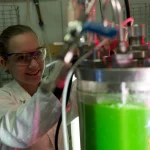How microalgae boost sustainability and CO₂ capture
Microalgae naturally absorb CO₂ from the air through photosynthesis and turn it into oxygen and biomass. They are one of the most efficient ways to reduce atmospheric CO₂. Unlike regular crops, microalgae grow well in closed systems, need little space, and can use salt or brackish water instead of fresh water or fertile soil. Their rapid growth and strong photosynthetic ability allow them to store up to ten times more CO₂ per area than most plants, making them an important ally in tackling climate change.
Microalgae as a source of sustainable nutrition
Microalgae pack a powerful mix of nutrients: omega-3 fatty acids, antioxidants, vitamins, and proteins. They offer a plant-based alternative to fish and meat without putting extra strain on oceans or farmland. Adding microalgae to our diets can help move food systems toward more sustainable practices with less environmental impact.
Microalgae for better animal feed
In aquaculture and livestock farming, microalgae can replace ingredients like fishmeal and soy. They support healthy growth and resilience in animals, while lowering the footprint of feed production. Using microalgae makes food production more efficient and better aligned with environmental needs.
Energy from microalgae
Microalgae can be turned into biofuels like biodiesel, bioethanol, and biogas. Their high fat and sugar content makes them a good raw material for renewable energy, without competing with food crops. Since the CO₂ released when the fuels are burned equals the CO₂ captured during growth, algae-based fuels offer a cleaner alternative to fossil fuels.
Cleaning water with microalgae
Microalgae also play a role in cleaning wastewater. They absorb nitrogen, phosphate, and organic pollutants, improving water quality and producing extra biomass that can be reused. This approach helps close the loop between water use and resource recovery.
New materials made from microalgae
Microalgae are increasingly used to make biodegradable plastics, natural pigments, cosmetics, and even medicines. These products reduce the need for fossil-based materials and support the shift to a circular economy based on renewable resources.
A practical answer to global challenges
Microalgae offer high yields without needing good farmland or much fresh water. By using sunlight, CO₂, and saltwater, they create valuable biomass that can help meet global needs for food, clean energy, and sustainable materials.
Big potential from tiny organisms
At AlgaSpring, we cultivate microalgae with a focus on quality, purity, and respect for the environment. By combining technology and nature, we want to make a real difference toward a healthier future.



